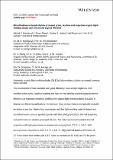Monothiatruxene-based, solution-processed green, sky-blue, and deep-blue organic light-emitting diodes with efficiencies beyond 5% limit
Abstract
The development of blue materials with good efficiency, even at high brightness, with excellent color purity, simple processing, and high thermal stability assuring adequate device lifetime is an important remaining challenge for organic light‐emitting didoes (OLEDs) in displays and lightning applications. Furthermore, these various features are typically mutually exclusive in practice. Herein, four novel green and blue light‐emitting materials based on a monothiatruxene core are reported together with their photophysical and thermal properties, and performance in solution‐processed OLEDs. The materials show excellent thermal properties with high glass transition temperatures ranging from 171 to 336 °C and decomposition temperatures from 352 to 442 °C. High external quantum efficiencies of 3.7% for a deep‐blue emitter with CIE color co‐ordinates (0.16, 0.09) and 7% for green emitter with color co‐ordinates (0.22, 0.40) are achieved at 100 cd m−2. The efficiencies observed are exceptionally high for fluorescent materials with photoluminescence quantum yields of 24% and 62%, respectively. The performance at higher brightness is very good with only 38% and 17% efficiency roll‐offs at 1000 cd m−2. The results indicate that utilization of this unique molecular design is promising for efficient deep‐blue highly stable and soluble light‐emitting materials.
Citation
Maciejczyk , M R , Zhang , S , Hedley , G J , Robertson , N , Samuel , I D W & Pietraszkiewicz , M 2019 , ' Monothiatruxene-based, solution-processed green, sky-blue, and deep-blue organic light-emitting diodes with efficiencies beyond 5% limit ' , Advanced Functional Materials , vol. 29 , no. 6 , 1807572 . https://doi.org/10.1002/adfm.201807572
Publication
Advanced Functional Materials
Status
Peer reviewed
ISSN
1616-301XType
Journal article
Description
The authors thank the Mazowieckie voivodeship, cofinanced with the European Union funds by the European Social Fund and European Union's Horizon 2020 Research and Innovation Programme H2020‐MSCA‐IF‐2014‐659237 for financial support. The authors thank Dr. Gary Nichol for the crystallographic data collection and refinement; The University of Edinburgh for funding the diffractometer purchase. I.D.W.S. acknowledges support from a Royal Society Wolfson Research Merit Award and from the Engineering and Physical Sciences Research Council (grant EP/J009016/1).Collections
Items in the St Andrews Research Repository are protected by copyright, with all rights reserved, unless otherwise indicated.

